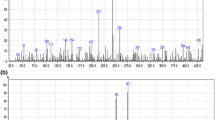Abstract
The Schiff base ligand 1-(4-((2-hydroxybenzylidene)amino)phenyl)ethan-1-one, obtained from 4-aminoacetophenone and salicylaldehyde, and its complexes with Fe(III), Co(II), Ni(II) and Cu(II) have been synthesized. These complexes were characterized by FTIR spectroscopy, elemental, and SCXRD analysis. FTIR spectra of complexes show the bidentate coordination of metal ions with ligands where O and N are electron-donating sites of the azomethine group. The electronic absorption spectra of these complexes show the characteristics of absorption bands involved in the Fe, Co, and Ni complexes due to their π→π*, n→π* transitions. Further, the geometry of the complexes was deduced from the calculated magnetic moment values and single crystal XRD analysis.
Graphical abstract
A Schiff base derived from the condensation reaction between 2-aminoacetophenone and salicylaldehyde was involved in the formation of four different metal complexes, i.e., with Nickel, Cobalt, Iron, and Copper. The synthetic route to forming these complexes followed an easy process, and the complexes were obtained in good yields.






Similar content being viewed by others
References
Gupta K C and Sutar A K 2008 Catalytic activities of Schiff base transition metal complexes Coord. Chem. Rev. 252 1420
Dhanaraj C J, Johnson J, Joseph J and Joseyphus R S 2013 Quinoxaline-based Schiff base transition metal complexes: review J. Coord. Chem. 66 1416
Abu-Dief A M and Mohamed I M A 2015 A review on versatile applications of transition metal complexes incorporating Schiff bases Beni-Suef Univ J. Basic Appl. Sci. 4 119
Alias M, Kassum H and Shakir C 2014 Synthesis, physical characterization and biological evaluation of Schiff base M(II) complexes J. Assoc. Arab Univ. Basic Appl. Sci. 15 28
Malik S, Ghosh S and Mitu L 2011 Complexes of some 3d-metals with a Schiff base derived from 5-acetamido-1, 3, 4-thiadiazole-2-sulphonamide and their biological activity J. Serb. Chem. Soc. 76 1387
Raman N, Johnson Raja S, Joseph J and Dhaveethu Raja J 2007 Synthesis, spectral characterization and dna cleav-age study of heterocyclic schiff base metal complexes J. Chil. Chem. Soc. 52 1138
Silva A R, Budarin V, Clark J H, Castro B de and Freire C 2005 Chiral manganese(III) Schiff base complexes anchored onto activated carbon as enantioselective heterogeneous catalysts for alkene epoxidation Carbon 43 2096
Zhang X and Llabrés i Xamena F X and Corma A, 2009 Gold(III)–metal organic framework bridges the gap between homogeneous and heterogeneous gold catalysts J. Catal. 265 155
Ejidike I P and Ajibade P A 2015 Transition metal complexes of symmetrical and asymmetrical Schiff bases as antibacterial, antifungal, antioxidant, and anticancer agents: progress and prospects Rev. Inorg. Chem. 35 191
Prakash A and Adhikari D 2011 Application of Schiff bases and their metal complexes-a review Int. J. Chem. Tech. Res. 3 1891
Tumer M, Akgun E, Toroglu S, Kayraldiz A and Donbak L 2008 Synthesis and characterization of Schiff base metal complexes: their antimicrobial, genotoxicity and electrochemical properties J. Coord. Chem. 61 2935
Das P and Linert W 2016 Schiff base-derived homo-geneous and heterogeneous palladium catalysts for the Suzuki-Miyaura reaction Coord. Chem. Rev. 311 1
Deligonul N, Tumer M and Serin S 2006 Synthesis, characterization, catalytic, electrochemical and thermal properties of tetradentate Schiff base complexes Trans. Met. Chem. 31 920
Cozzi P G 2004 Metal-Salen Schiff base complexes in catalysis: practical aspects Chem. Soc. Rev. 33 410
Kurup M R P, Varghese B, Sithambaresan M, Krishnan S, Sheeja S R and Suresh E 2011 Synthesis, spectral characterization and crystal structure of copper(II) com-plexes of 2-benzoylpyridine-N(4)-phenylsemicarbazone Polyhedron 30 70
Raman N, Raja J D and Sakthivel A 2007 Synthesis, spectral characterization of Schiff base transition metal complexes: DNA cleavage and antimicrobial activity studies J. Chem. Sci. 119 303
Cristóvão B 2011 Spectral, thermal and magnetic properties of Cu (II) and Ni (II) complexes with Schiff base ligands J. Serb. Chem. Soc. 76 1639
Author information
Authors and Affiliations
Corresponding author
Supplementary Information
Below is the link to the electronic supplementary material.
Rights and permissions
About this article
Cite this article
Ansari, R.M., Ramakrishna, D. & Bhat, B.R. Thermally stable complexes of Fe(III), Co(II), Ni(II) and Cu(II) with Schiff base derived from 4-aminoacetophenone and salicylaldehyde. J Chem Sci 134, 117 (2022). https://doi.org/10.1007/s12039-022-02113-6
Received:
Revised:
Accepted:
Published:
DOI: https://doi.org/10.1007/s12039-022-02113-6




